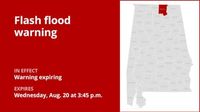On August 20, 2025, residents across northwestern North Carolina and southwestern Virginia found themselves facing a sudden and dangerous threat as the National Weather Service in Blacksburg, Virginia, issued a Flash Flood Warning at 4:02 PM EDT. The warning, which extended until 10:00 PM EDT, covered Alleghany County, Ashe County, southeastern Watauga County, and central Wilkes County in North Carolina, as well as southern Grayson County in Virginia. According to the National Weather Service, Doppler radar had indicated heavy thunderstorms dumping between two and three inches of rain across the region, with flash flooding either already underway or expected to begin soon.
The impact of these storms was immediate and widespread. Flash flooding, the warning stated, was caused by intense thunderstorms and threatened to inundate small creeks, streams, urban areas, highways, streets, underpasses, and other low-lying or poorly drained spots. Specific towns and communities in the path included Boone, Sparta, Jefferson, West Jefferson, Blowing Rock, Independence, and Lansing. The warning also listed numerous streams and drainages at risk, such as Brush Creek, Beaverdam Creek, Bridle Creek, Bee Tree Branch, Bear Branch, Big Sandy Creek, Beaver Creek, Big Pine Creek, Big Horse Creek, and Basin Creek.
In a stark reminder of the dangers posed by floodwaters, the National Weather Service urged, "Turn around, don't drown when encountering flooded roads. Most flood deaths occur in vehicles." This caution was not just a slogan—it was a life-saving imperative. As little as 12 inches of rapidly flowing water can carry away most vehicles, making even seemingly shallow flooded roads potentially deadly, according to Advance Local Weather Alerts.
Meanwhile, in Madison County, the weather story was evolving. The heavy rain had tapered off by the time of the report, and the immediate threat of flooding had diminished. However, the National Weather Service cautioned residents not to let their guard down. "The heavy rain has ended. Flooding is no longer expected to pose an immediate threat. Additional thunderstorms could impact the warning area and may lead to additional flooding late this afternoon. Please continue to heed remaining road closures," the service stated. The message was clear: even after the worst seems to have passed, lingering hazards and the unpredictable nature of summer storms can quickly reignite danger.
Understanding the terminology around flood alerts is essential for public safety. As reported by Advance Local, a flash flood warning means action is required immediately—a flash flood is imminent or already occurring. Flood warnings, advisories, and watches signal varying degrees of risk, but only a warning means flooding is either happening or about to happen. Even areas not directly under rainfall can experience flash flooding due to runoff or upstream deluges.
In the face of such threats, safety guidelines from the weather service become crucial. Residents in flood-prone or low-lying areas are urged to seek higher ground at the first sign of danger. If evacuation orders are issued, they should be followed promptly—no hesitation, no second-guessing. Before leaving, securing the home and disconnecting utilities and appliances, if time allows, can minimize the risk of electrical hazards. Entering flooded basements or rooms with submerged outlets is strongly discouraged, as is walking through floodwaters. Even a mere six inches of fast-moving water can knock a person off their feet, according to the National Weather Service. If trapped by moving water, the advice is to climb to the highest available point and call 911 for help.
Driving poses its own set of hazards during flash floods and heavy rain. The weather service advises never to drive through flooded roads, no matter how shallow they appear. "Most flood deaths occur in vehicles," the agency reiterates. During heavy rainfall, drivers are encouraged to maintain greater distances between cars—using the two-second rule and adding extra time in wet conditions—slow down, and avoid sudden braking to prevent skidding. Choosing middle lanes, where water is less likely to accumulate, can help reduce the risk of hydroplaning. Visibility is another concern: headlights should be on, and caution should be exercised around large vehicles to avoid losing sight in the spray. The first half-hour of rainfall is particularly treacherous, as oil and grime mix with water to create slick surfaces. If visibility drops so low that the road ahead or other vehicles are hard to see, the safest course is to pull over—preferably at a rest area or protected spot—and wait for the storm to pass. If stopping on the roadside is the only option, drivers should pull off as far as possible, keep headlights and emergency flashers on, and stay inside the vehicle until conditions improve.
The National Weather Service and Advance Local Weather Alerts stress the importance of being prepared and informed. Floods can develop in minutes or hours, and the risk is heightened in regions with saturated ground or intense rainfall. The unpredictability of summer storms means that even after the heaviest rain has moved on, the potential for flash flooding remains if new storms develop or runoff continues to flow downstream. Heeding road closures and official guidance is vital, as is staying alert to changing weather conditions.
For communities like Boone, Sparta, and Jefferson, the events of August 20 served as a sobering reminder of nature's power and the importance of vigilance. The weather service's advice to "turn around, don't drown" is more than a catchphrase—it's a call to action that can save lives. As climate patterns shift and extreme weather events become more common, understanding, respecting, and responding to weather alerts is essential for individual and community safety.
While the storms of August 20, 2025, brought disruption and anxiety to many, they also showcased the value of timely warnings, clear communication, and community preparedness. With more storms always on the horizon, staying informed, heeding official advice, and never underestimating the risks of flooding remain the best defenses against the unpredictable forces of nature.




